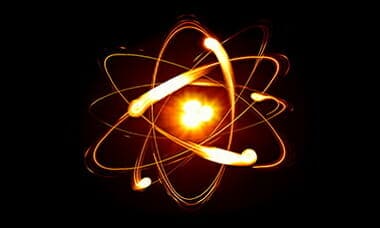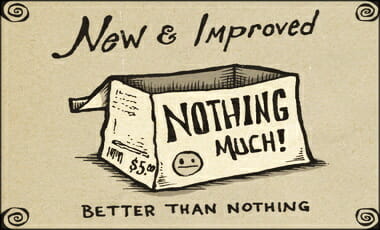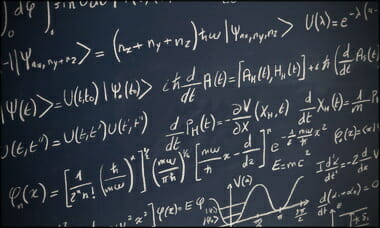(Originally Published March 2016)
- “One of the things about quantum mechanics is not only can nothing become something, nothing always becomes something,” says Dr. Krauss. “Nothing is unstable. Nothing will always produce something in quantum mechanics.”
Commenting on Krauss’ central claim that particles emerging from the quantum vacuum are like creation out of nothing, Dr. Albert writes:
But that’s just not right. Relativistic-quantum-field-theoretical vacuum states — no less than giraffes or refrigerators or solar systems — are particular arrangements of elementary physical stuff. The true relativistic-quantum-field-theoretical equivalent to there not being any physical stuff at all isn’t this or that particular arrangement of the fields — what it is (obviously, and ineluctably, and on the contrary) is the simple absence of the fields! The fact that some arrangements of fields happen to correspond to the existence of particles and some don’t is not a whit more mysterious than the fact that some of the possible arrangements of my fingers happen to correspond to the existence of a fist and some don’t. And the fact that particles can pop in and out of existence, over time, as those fields rearrange themselves, is not a whit more mysterious than the fact that fists can pop in and out of existence, over time, as my fingers rearrange themselves. And none of these poppings — if you look at them aright — amount to anything even remotely in the neighborhood of a creation from nothing (emphasis in the original).
[….]
A quantum vacuum, on the other hand, is something—it consists of fields of fluctuating energy from which particles appear to pop in and out of existence. Whether these particles are uncaused, or are caused but are merely unpredictable to us, is unknown. There are ten different models of the quantum level [the most accepted of those is the Copenhagen interpretation], and no one knows which is correct. What we do know is that, whatever is happening there, it is not creation out of nothing. Moreover, the vacuum itself had a beginning and therefore needs a cause.
This is a couple page excerpt from Dr. John Polkinghorne’s chapter entitled, “God and Physics”:
- William Lane Craig and Chad Meister, God Is Great, God Is Good: Why Believing in God Is Reasonable and Responsible (Downers Grove, IL: IVP, 2009), 74-77.
GOD, EVOLUTION AND QUANTUM THEORY
The potentiality present in the laws of nature has been turned into actuality in the course of the 13.7 billion years of cosmic history by a variety of evolutionary processes. While the biological evolution of life on earth is the most familiar of these scenarios, evolutionary process has also been of great significance for the physical structure of the universe. In the course of the first billion years of cosmic history, the initial almost uniform ball of matter-energy turned into a world that became grainy and lumpy with stars and galaxies. Where there had been a little more matter than average, there was an additional gravitational attraction, which then drew in further matter in a kind of snowballing process. In this way the initial small inhomogeneities were enhanced to produce ultimately a starry universe.
The essence of any evolutionary process is an interplay between contingent variations (in this case, small fluctuations of matter density in the early universe) and lawful regularity (in this case, the force of gravity). A slogan way of expressing this is to talk about chance and necessity. It is important to recognize that in this phrase “chance” is by no means a sign of meaninglessness but stands for the contingent particularity of what actually happens. Even in the course of 13.7 billion years, only a tiny fraction of what could have happened has actually taken place. The formation of stars and galaxies illustrates the general scientific insight that regimes in which true novelty emerges are always “at the edge of chaos,” where order and openness, chance and necessity are interwoven. Too far on the orderly side of that frontier, and things are too rigid for the emergence of anything really novel to be possible; too far on the haphazard side of the frontier, and no novelty that does emerge will be able to persist.
The theist has no need to be worried by the widespread role of evolutionary process. God is the ordainer of nature, and God acts as much through natural processes as in any other way. Commenting on Charles Darwin’s great discovery of biological evolution, his contemporary Charles Kingsley said that we had been shown that God had not made a ready-made world but had done something cleverer than that, making a world in which creatures “could make themselves.” chance is simply creation’s shuffling exploration of divinely given fertility, by means of which potentiality is made actual. The theist will see the twin roles of chance and necessity as the gifts to creation of both independence and reliability, by a God who is both loving and faithful.
The physicist may well see this interweaving of order and openness reflected in the character of quantum physics and speculate that at the subatomic level this has been an important property in allowing the universe to be biofertile. While quantum physics is only capable of assigning probabilities for a number of possible results of a measurement, the range of these possibilities is also constrained by the actual character of the wave function describing the system. It is certainly not the case that anything might happen. The wave function itself evolves in time according to the Schrodinger equation, which is a deterministic differential equation. According to the widely accepted indeterministic interpretation of quantum theory, it is only when the definite form of the wave function is used to calculate the consequences of a measurement that probabilities enter the theory. Most physicists understand measurement to be the irreversible macroscopic registration of a state of affairs in the subatomic system, and it is not necessarily associated with the direct influence of a conscious observer. In other words, surely quantum processes had actual outcomes over the many billion years of cosmic history in which there were no observers present in the universe.
The interpretation of quantum theory is still a contentious issue, with a variety of incompatible points of view being advocated, but the notion of “observer-created reality” is very much a minority position. At most, “observer-influenced reality” (in laboratory experiments affected by choices of what measurements to make) is as much as should be said.
Quantum theory has also contributed to a growing recognition that nature is deeply relational and that atomism is only part of the picture. Once two quantum entities have interacted with each other, they can retain a power of mutual influence that is not diminished by spatial separation. Acting on one here will have an immediate effect on the other, even if it is now “beyond the moon,” as we conventionally say. Einstein was the first to recognize the possibility of quantum entanglement, but he thought it was “too spooky” to be true. He considered that its prediction must show that there was something wrong with conventional quantum mechanics. However, experiments have abundantly confirmed the phenomenon. The instantaneous character of the influence conveyed does not contradict special relativity, since it turns out that it cannot be used to transmit information faster than the velocity of light. Nature, it seems, rebels against a crass reductionism: even the subatomic world cannot be treated atomistically. The theist who is a trinitarian thinker will not be surprised to learn that created reality is relational.
Finally, physicists can not only peer into the universe’s past but also foresee aspects of its future. The timescales are very long, but in the end the prediction is that it will all end badly. As far as the earth is concerned, in about five billion years the sun will have consumed all its hydrogen fuel. It will then turn into a red giant, burning to a frazzle any life then left on the earth. By then life might well have migrated elsewhere in the galaxy; that, however, would only be a temporary reprieve. Over immensely long timescales, the universe itself will die, most probably by continuing to expand and becoming ever colder and more dilute. Carbon-based life will certainly prove to have been a transient episode in the history of the universe.
Eventual futility lies at the end of science’s “horizontal” story, extrapolating physical process into the distant future. However, theism has a different, “vertical” story to tell, based on the everlasting faithfulness of God. For the religious believer, the last word lies not with death but with God. That is a conviction that goes beyond anything that physics can speak about, either for or against.
FOR FURTHER READING
- Holder, Rodney. God, the Multiverse and Everything. Aldershot, U.K.: Ashgate, 2004.
- Polkinghorne, John. Belief in God in an Age of Science. New Haven: Yale University Press, 1998.
- _________Quantum Theory: A Very Short Introduction. Oxford: Oxford University Press, 2002.
- _________Quantum Physics and Theology. New Haven: Yale University Press, 2007.
- Smolin, Lee. The Trouble with Physics. London: Allen Lane, 2006.
Here as well is an article from my Study Bible:
- Jeremy Royal Howard, “Does the ‘New Physics’ Conflict with Christianity?,” in The Apologetics Study Bible: Real Questions, Straight Answers, Stronger Faith, ed. Ted Cabal et al. (Nashville, TN: Holman Bible Publishers, 2007), 1306–1307.
The Bible portrays God as a rational Being who created the world from nothing and rules over it as Sovereign. Logic, order, purpose, natural law—these qualities are etched into the universe as reflections of the will and mind of God. Moreover, God made humans in His own image, which means our minds are equipped to operate according to God’s rationality. Finally, since God is the author of the world and humanity, we are intellectually ready-made to understand truth about God and the world He made.
Some people say quantum mechanics (QM) refutes these beliefs. QM studies the bits of matter that are the size of atoms and smaller. It was long assumed that these micro-objects would follow the physical laws Newton described, but modern research shows that quantum entities behave far differently than the objects of our everyday experience. For example, photons (light) can take the form of particles or waves. However, the problem is that waves and particles are contrary things. Waves cover a wide zone, but particles can only be at one tiny place at a time. Physicists are baffled that photons can do both. Next, tests reveal that in laboratory settings, quantum particles separated by a vast expanse can still affect one another as if they are in direct contact. This is like scratching someone’s back from two thousand miles away. Finally, experiments suggest that quantum entities behave lawlessly, meaning there are no “rules” for their actions.
These oddities prompt some observers to conclude that QM overturns natural law and rationality, leaving us with an incomprehensible, uncreated universe. Standard physics says matter can be neither created nor destroyed by natural means, but some scientists (falsely) claim that quantum particles naturally pop in and out of existence. From this, leading atheists claim the whole universe “sprang” into existence naturally. No Creator necessary. Furthermore, they say that even if God exists and created the universe, QM shows He made a world He cannot control. Once He uncorked this world, not even God knows what will come of it. Theologians who favor science fads over Scripture conclude the same thing: QM implies God cannot govern creation or know the future.
Scientists have historically taken the appearance of mystery or irrationality in nature as a sign that they do not yet know enough about the object under study. However, following the lead of Niels Bohr’s Copenhagen Interpretation (CI) of QM, many physicists refuse to count their inability to understand or predict quantum action as a sign of ignorance. Rather, they claim QM is basically a finished science that reveals a genuinely lawless and irrational world—a brooding cauldron of chance actions and purposeless conclusions. This fits well with non-Christian concepts of the universe. In fact, Bohr and his colleagues enthusiastically asserted that QM endorses Eastern worldview images. Today, popular science opinion is captive to Bohr’s CI, and thus holds that QM supports New Age or atheistic worldviews.
I suggest the following starting points for the Christian response: First, for all the wild attributes that may hold true in QM, we note that macroscopic reality behaves in a predictable, law-like fashion and everywhere presents us with evidence of its fundamentally rational construction and operation. So even if quantum particles could do lawless things like pop in and out of existence naturally, no such thing happens in the realm of everyday objects. Quantum oddities, whatever you make of them, are detained at the door to the larger realities we experience.
Second, many of the astounding behaviors attributed to QM occur only in highly artificial laboratory settings. There is no certainty that these things can actually happen in real-world settings. Thus, we are justified in casting an indifferent eye on many of the zany headlines coming from physics laboratories.
Third, science’s ability to penetrate the microphysical world is still very rudimentary. This leaves room for exceptionally high degrees of speculation and error. In this light, Christians should join the chorus of noteworthy scientists (like Einstein) who have insisted that QM should not be the basis for worldview assertions. This problem will apparently not be fully alleviated in the future, for scientists acknowledge that the mega-scale facilities and energies required to verify the most important claims of QM will forever lie outside our reach.
Fourth, science would be impossible if this world were not created by a personal, rational Being who designed both physical reality and human beings to reflect His rationality. Any scientific theory that supports non-rational worldviews is self-defeating. After all, the deliberations involved in reaching the conclusion that “this world is fundamentally irrational” have relied on the very rationality whose legitimacy is denied in the conclusion.
Finally, a growing body of experts believes the CI will someday fall out of scientific favor, thus shifting the dominant paradigm of QM to models supporting rationality and natural law. Whether or not this happens, Christians can rest assured that this world is the creation of a rational God who rules as Sovereign over all things, including the wily objects of the quantum realm.
Besides QM, some suggest Chaos Theory and Special Relativity impinge on the Christian worldview. Special Relativity shows there are no fixed reference points in the universe. All motion or apparent non-motion is relative to a specific frame of reference. Some have imagined that this undermines our ability to form fixed judgments that apply universally, but of course our inability to do this in physics is irrelevant to our assurance about unalterable, universal truths revealed by God. As for Chaos Theory, the name itself is deceptive. Properly understood, it only says that many deterministic physical systems are so sensitive to initial conditions that we cannot fully predict their future behaviors unless we perfectly comprehend all of those conditions. Hence it is our ignorance, not creation itself, which sets up the appearance of chaos in physics.
In summary, the new physics highlights human finitude but does nothing to overturn God as Author and Ruler of creation.
And Frank Turek answers the issue in a manner that uses science and experience via science. In other words, while scientists do not know all the ins-n-outs of the quantum theory on it’s “sub-atomic level,” there is NOTHING to suppose the laws of science or logic are undermined. None:
Some atheists will appeal to the quantum level to question the law of causality. But just because we can’t predict cause and effect among subatomic particles, doesn’t mean that there is no cause and effect. That could be a matter of unpredictability rather than uncausality. In other words, the limits of our knowledge of the quantum level might be the issue.
Moreover, any conclusion the atheist makes about the quantum level would use the very the law of causality he is questioning. That’s because his observations of the quantum level and his reasoning about it use the law of causality! While it is possible that causality does not apply at the quantum level, given the fact that the law seems universal everywhere else and the scientist uses it in all of his conclusions, why would anyone conclude it’s more plausible to believe that causality does not apply at the quantum level? Could it be because it helps one avoid God?
Frank Turek, Stealing from God (Colorado Springs, CO: NavPress, 2014), 233-234; Does Causality Apply Outside of Space and Time? (Cross Examined).


